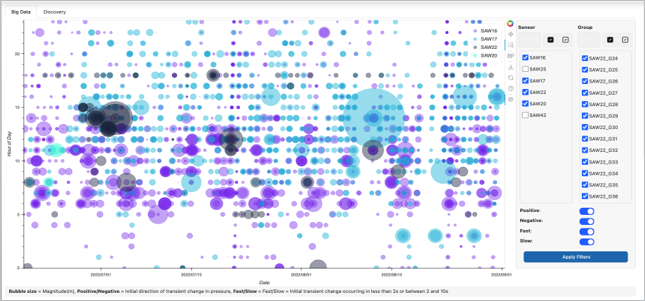Water utilities in Australia and New Zealand face the ongoing challenge of maintaining the integrity of their vast pipeline networks. Pressure transients are typically triggered by rapid changes in flow, such as pump start-ups or shutdowns, valve operations, or unexpected system failures. Pressure transients are known to cause the majority of pipe bursts, significantly reduce pipe asset life and reduce customer service levels. To mitigate the risk of pressure transients, utilities are increasingly turning to data analytics and smart water network technologies.
The Role of Data Analytics in Water Network Management
Data analytics has revolutionised the way utilities monitor and manage their water networks. By leveraging vast amounts of data generated from sensors, meters, and other monitoring devices, utilities can gain valuable insights into the behavior of their systems. This data-driven approach enables utilities to move from reactive to proactive management, where potential issues are identified and addressed before they escalate into costly failures.
One of the key benefits of data analytics is its ability to detect pressure transients that would previously go unnoticed and cause havoc through a water network. By continuously monitoring pressure at a high rate (>100Hz) utilities can identify patterns and anomalies that can lead to identifying the root cause of a repeated transient event. For instance, a sudden drop in pressure followed by a sharp increase could signal the start of a pressure transient that may occur in milliseconds. Algorithms are able to auto-detect this information enabling utilities to take immediate action to prevent or mitigate the cause of the event.
Pressure-Induced Pipe Stress and AI-Driven Insights
Predictive modeling is another powerful tool that utilities can be used to anticipate and prevent pressure transients. By analysing historical data and applying advanced algorithms, utilities can create models that estimate the pressure cycles that have accumulated and then predict the future stress load. These models can simulate various scenarios, such as pump operations, valve closures, and changes in demand, to identify potential triggers for pressure transients for immediate mitigation tactics.
AI-driven insights take predictive modeling a step further by continuously learning from new data and refining predictions over time. Machine learning algorithms can analyse vast amounts of data, identify patterns, and provide actionable recommendations. For example, algorithms can i) identify the pressure transients most likely to cause pipe bursts in the future as well as ii) estimate the end of pipe life based on current pressure transient patterns. As a result, this helps utilities prioritise maintenance and repair activities based on the likelihood of pressure transients occurring in specific parts of the network.
Real-Time Data Collection and Smart Water Networks
The foundation of predictive analytics and AI-driven insights is real-time data collection. Smart water networks, equipped with advanced sensors and IoT devices, enable utilities to continuously monitor their systems in real-time. These devices collect data on pressure, flow, temperature, and other critical parameters, providing a comprehensive view of the network’s performance.
Software like TD.Cloud offers innovative solutions that integrate real-time data collection with advanced analytics. By deploying smart sensors throughout the network, utilities can capture high-resolution data on pressure transients as they occur. This data is then analysed in real-time to identify the root cause of the transient and determine the best course of action. TransientDetect’s technology also allows for remote monitoring, enabling utilities to respond quickly to transient events, even in remote or hard-to-reach areas.

TD·Cloud user interface dashboard showing pressure transients across 3 months by time of day for a few select locations.
Implementing Timely Interventions
Armed with real-time data and predictive insights, utilities can implement timely interventions to prevent or mitigate the impact of pressure transients and thereby reduce pressure-induced fatigue. This might involve adjusting pump operations, modulating valve settings, or deploying surge protection devices. In some cases, utilities may need to carry out targeted maintenance or repairs to address underlying issues that contribute to pressure transients. This is turn, calms the network and avoids costly shortened asset life.
The benefits of these interventions are clear. By preventing pressure transients, utilities can reduce the risk of pipe bursts, leaks, and other infrastructure failures. This not only helps to protect critical assets but also minimizes water loss, reduces maintenance costs, and ensures a reliable supply of water to customers.
As water utilities in Australia and New Zealand continue to modernise their infrastructure, leveraging data analytics and smart water network technologies will play a crucial role in ensuring the reliability and resilience of their systems. By predicting and preventing pressure transients, utilities can safeguard their assets, reduce operational costs, and provide better service to their communities.
Innovative solutions like TD.Cloud are leading the way in this field, offering utilities the tools they need to stay ahead of potential risks and maintain the integrity of their water networks.
Get in touch with us today to discuss how we can help manage the impact of pressure transients on your water network.









